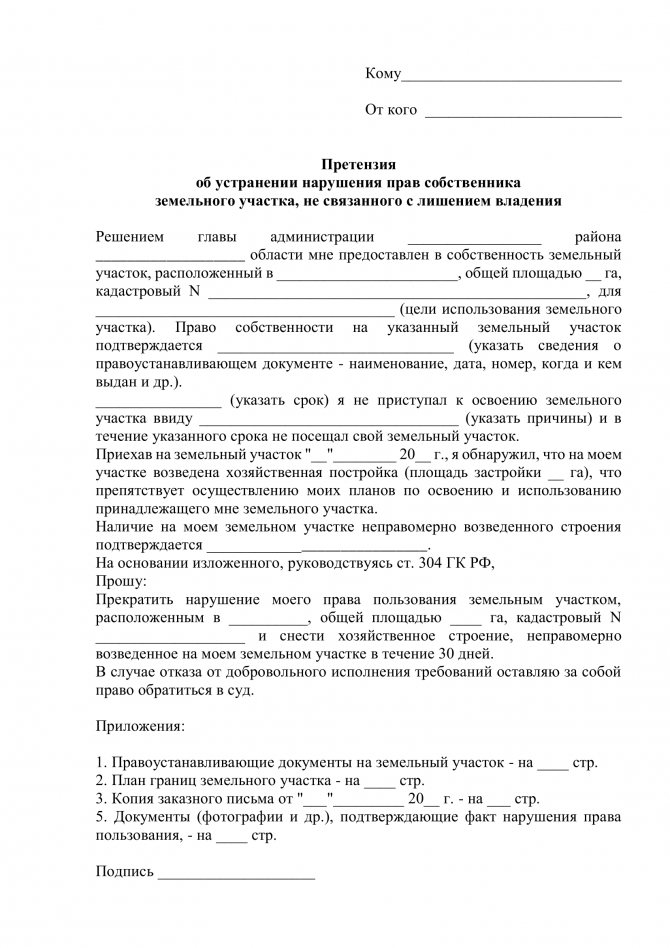What happens if a neighbor seizes part of the land plot and erects buildings there?
In practice, proceedings concerning the determination of the true boundaries of land plots are not uncommon.
Even if you have title documents for the plot, there is a possibility of parting with part of it. This can happen if neighbors in the adjacent territory initiate work to establish boundaries. They have the right to invite a cadastral engineer to their site, who will take the necessary measurements to carry out the land surveying procedure. Quite often, land owners are interested in whether neighbors in this case can appropriate part of the land for themselves if land surveying of the adjacent land was NOT carried out by its owner?
There are plenty of cases when part of someone else's land is seized by deception. There are many deceptive ways to do this. The most common is to negotiate with a cadastral engineer. When carrying out land surveying, documents are drawn up for a plot larger in size than it actually is. Such plots are quickly put up for sale, the former owner receives his profit, and you find out about the fact of deception when the new owner of the land comes to you with a demand to move the fence and vacate part of the plot.
This type of land use, like any existing one, is mentioned in the Land Code of the Russian Federation, since it is it that regulates and regulates all issues related to the use of land resources in our country.
Article No. 85 of the Land Code of the Russian Federation mentions PDO.
According to this article, public lands may be part of various territorial zones, but in no case are they subject to privatization. Also, under this article, squares, streets and driveways, highways and highways, embankment areas, boulevards, water bodies and beaches are included in the PDO.
Let's talk in more detail about unauthorized seizures. As already mentioned in the previous paragraph, all violations regarding the PDO must be provided for by the law of our country.
This type of land use violation as unauthorized seizure of territory intended for public use is considered an administrative offense and is regulated by Article 7.1 of Chapter 7 of the Code of Administrative Offenses of the Russian Federation.
Investigations into this offense are carried out by state federal inspectors specializing in the use and protection of those records that are included in Rosreestr. The article regulating this violation is called “Unauthorized occupation of land.”
According to it, occupying a PDO of one’s own free will in cases where there are no documents for this that are provided for by law (or in cases where there are no documents to permit economic activity) entails administrative liability. Namely, a fine for an individual in the amount of 500-1000 rubles, for an official from 1000 to 2000 rubles and for a legal entity from 2000 to 20,000 rubles.
In addition, regarding squatting, Article No. 21 of Chapter 23 of the Code of Administrative Offenses of the Russian Federation applies, which is called “Bodies exercising state control over the operation and protection of land plots.”
These public service bodies are the following:
- Chief State Inspector of the Russian Federation for the protection and exploitation of land, as well as his deputies.
- Chief state inspectors of individual regions of the Russian Federation for the protection and exploitation of land, as well as their deputies.
- Chief city and district state inspectors for the protection and exploitation of land, as well as their deputies.
Let's look at situations in which PDOs are taken without permission, what they can lead to, and why these situations are not legal.
Buildings, as everyone knows and understands, must be located on the territory of their owner’s land, and in accordance with the specified standards, observing all the indentations in accordance with fire safety and other standards.
The construction of a garage does not require permission and is not subject to any control, but the garage, nevertheless, must be located within the boundaries of the land plot. But there are cases when the owner built a garage so that part of it faces a road zone, which is a PDO, which is illegal and is a reason to contact Rosreestr.
The Rosreestr website provides information about the activities of the organization and their fight against crime.
On their website you can find many examples of illegal handling of PDO.
One of them was that in the Orenburg region a man surrounded his plot of land with a fence, capturing part of the road, which made movement along it difficult.

The owner of the site can either pay a fine of 5 to 10 thousand rubles, or receive the right to expand the site in order to avoid demolition of the fence. Such an act is an offense, since according to the Land Code of the Russian Federation, when fencing his land plot, the owner must make a retreat in front of the roadway, otherwise the door/gate should open towards the plot, and not towards the road. It is illegal to move the fence outside the boundaries of the property.
Illegal building
If the position of the garage on the site is not regulated, then non-permanent outbuildings and permanent buildings are subject to rules for their location on the site; building a house generally requires a building permit.
That is why a building outside a site that is not in personal ownership, but on a PDO, is a significant offense. Therefore, when a neighbor decides to build a shed in the middle of the road, this is a reason to ask for an inspection.
The road and the approach to the house are a public area; blocking the path along it with anything - a garage, a fence, a doghouse or a shed - is illegal.
Before considering such an example, let's familiarize ourselves with the concept of common ownership. This issue is already regulated by the Housing Code of the Russian Federation, Articles 37 and 162.
According to the Housing Code of the Russian Federation, common property is such common areas (including property) that belong to the owners of the premises of an apartment building, provided that the share of common property is proportional to the area of the owner’s apartment, and also provided that the allocation and abandonment of these shares is prohibited in law.
As for the composition of common property, it includes:
- premises in an apartment building that are not parts of apartments and are intended to serve more than one residential and (or) non-residential premises in this apartment building;
- roof areas;
- enclosing non-load-bearing and load-bearing structures of an apartment building;
- a plot of land on which an apartment building is located and the boundaries of which are determined on the basis of state cadastral registration data, with elements of landscaping and landscaping;
So, as for the example, in practice it often happens when one of the residents seizes common property in an apartment building.
When PDOs are used as a landfill, it is illegal for several reasons. Firstly, such landfills can serve as an obstacle to the intended use of PDOs. And secondly, landfills are quite harmful territories, and if they are located in places not intended for them, this can result in harm to the health of citizens and the environment. It is difficult to find the culprit in littering, since many citizens may be involved.
When registering a new plot or purchasing it on the secondary market, a cadastral engineer, at the owner’s request, carries out land surveying. This is necessary in order to determine the boundaries of the acquired land.
The need to carry out cadastral work, as well as all the nuances, is discussed in detail in regulations, which include the Land, Civil, Town Planning Codes, federal laws “On Cadastral Activities”, “On State Registration of Real Estate” and others.
Briefly about determining the boundary of the memory, we will say that:
- this work is performed only by a licensed cadastral engineer;
- land surveying is necessary when conducting any transaction (purchase and sale, exchange, allocation of shares, etc.);
- a plot whose boundaries are not defined cannot be registered with Rosreestr and registered as property;
- Land survey results are always agreed upon with neighbors.
We suggest you read: Which accounts cannot be seized by bailiffs
Step 1. We invite a specialist and enter into an agreement with him.
Step 2. We notify neighbors about the date and location of the survey.
Step 3. The engineer carries out cadastral work - determines the boundaries (read about how the boundaries of the site are established) and the coordinates of the site.
Step 4. Draws up a boundary plan.
Step 5. The results are agreed upon with the customer and stakeholders.

Step 6. Register the property in Rosreestr or make changes.
Despite the fact that defining boundaries is a mandatory procedure, situations occur when owners do not comply with land and civil legislation and affect the interests of neighbors.
Violation of the boundaries of a land plot is always associated with land seizure. In practice, there are often cases when disputes arise between the owners of adjacent plots regarding the unlawful taking of neighboring territory.
Boundaries can be considered violated if a fence is installed deep into an adjacent plot or when any object, as well as part of it, is built on someone else’s territory. Such situations arise not only due to deliberate seizure, but also due to mistakes made by the cadastral engineer.
Reasons for violating the boundaries of the memory:
- unauthorized seizure;
- land surveying errors (read about what to do if the land survey turns out to be larger);
- lack of land surveying;
- contradictions in old documents;
- entering irrelevant data into the Unified State Register of Real Estate.
When is it possible that disputes with neighbors may arise and how to resolve them?
In most cases, disputes arise regarding the boundaries of adjacent areas due to errors in their delimitation. Modern technologies make it possible to determine boundaries with millimeter accuracy, but in the Soviet years this was impossible. People used classical measurement methods, and this is where errors arose.
Their determination occurs at a later period, during the land surveying procedure. Deliberate seizure of property cannot be ruled out. For example, a neighbor thought that his plot was too small and he installed a fence, partially encroaching on the adjacent territory, hoping that its owners would not notice anything.
Based on the results of the oral agreement, the neighbor is obliged to:
- Restore the legal boundaries of the site.
- Return the land to its original appearance.
The neighbor will have to move the existing fence, demolish buildings (if they affected part of the neighbor’s territory), and remove garbage at his own expense. What to do if it is impossible to resolve the issue through mutual agreements? The injured party will have to go to court. Based on its results, the neighbor will have to not only return part of the land and restore its original appearance, but also pay material compensation for the damage caused.
- Deliberate.
- Unintentional.
Deliberate actions include clearly thought-out actions of illegal seizure of part of the land. As a rule, this happens long before the actual boundaries of the site are established. For example, after allocating land, neighbors fence off their property with stakes and strings, and seeing that the adjacent plot is empty, they arbitrarily move the boundaries several meters or more.
The discovery of violations may occur after several years or decades, which pushes neighbors to take a criminal step. Actions of an unintentional nature arise due to a combination of circumstances. There may be errors on the part of the geodetic company that carried out the survey, the workers who installed the fence, or the owners who took the measurements incorrectly.
Illegal occupation of a plot may occur due to errors made during land surveying. Inconsistency between the established boundaries and the information entered in the Unified State Register is also classified as unlawful seizure.

Self-occupation can also occur in the case when a citizen, in order to expand his own allotment, moves the boundaries, occupying a plot that does not belong to him.
In accordance with Art. 304 of the Civil Code of the Russian Federation, everyone has the right to demand that violations of their rights be eliminated. Therefore, if the owner finds out about the shift in the boundaries of his plot, then the rights to the captured territory are subject to restoration. However, he may not demand the return of this territory, but give or sell it to a neighbor. The latter can annex the captured part of the plot to his own and transfer new data to the Cadastral Chamber.
If a neighbor has somehow seized part of a land plot, then first of all you can go to peaceful negotiations with him. To do this, an informal personal meeting is enough to clarify why the boundaries were violated. If it was an unauthorized seizure and everything is in order with the documents, then the violator can simply move the fence to the right place.
Case from practice
The situation is as follows: Marina, a resident of Krasnoyarsk, inherited a plot of land in a rural area. It previously belonged to her mother, who recently lived with her daughter in the city. No one looked after or looked after the house and grounds.
In 2021, the owner of the adjacent property installed a new fence, expanding his property by 4 meters, thinking that the abandoned property had no owner.

While registering ownership of the inherited plot, Marina found out that the actual dimensions did not correspond to those established in the documents.
In May 2021, she contacted our lawyer with a question about restoring rights to the seized part of the site. First of all, she was asked to talk to her neighbor and try to resolve the dispute without going to court.
After negotiations, the neighbor agreed to move the fence to its original location, since the boundaries in his documents were precisely defined and the seizure of the territory was carried out on his initiative.
Unfortunately, it is not always possible to reach a peaceful agreement. And most conflicts are resolved only through the courts. It is important to note here that in accordance with Art. 208 of the Civil Code of the Russian Federation, disputes related to infringement of land ownership rights do not have a statute of limitations. That is, you can go to court at any time when you become aware of a violation of the boundaries of the site.
In this case, the person whose rights are affected files a claim in the district court. As a rule, such cases are considered in the presence of the parties and with the involvement of third parties (cadastral engineer, administration representative, witnesses, etc.).
As for disputes with legal entities, the claim in this case is submitted to the arbitration court. Otherwise, the consideration of cases is similar to courts of general jurisdiction.
You can file a claim yourself. However, in order for the court not to refuse, it is important to complete the application in accordance with all requirements.
Contents of the claim:
- Name of the judicial authority.
- Full name and details of the plaintiff and defendant.
- Provide information about the land, part of which is disputed territory:
- when and on what grounds ownership of the plot began;
- information about the title document;
- land area;
- other data.
- Describe the circumstances under which the conflict arose.
- What measures were taken to resolve the dispute (for example, negotiations).
- Specify the requirement of the statement of claim.
The last point is very important. First of all, it is necessary to determine for yourself what the plaintiff wants to receive: determination of boundaries, restoration of rights to the seized part, confiscate the land or part of it from the invader, receive compensation.
As an attachment to the claim, it is necessary to provide copies of the passport, title document, boundary plan (if any), extract from the Unified State Register, etc. That is, everything that can serve as an evidence base. It is also important to remember that any certificate or other document must be received no earlier than six months before submitting the application.
Often neighbors claim that they did not know about the land survey and refer to the illegality of its results. In this case, proof may be an advertisement in the local media. Therefore, always keep a couple of copies of newspapers.
Sample FROM
The claim is filed with the court at the location of the site, and after acceptance, the judge makes a decision within a month to schedule a hearing or refuse to consider it. The plaintiff will be notified of this by sending a letter.
A state fee is charged for filing a claim. Its size is 300 rubles. citizens and 6,000 organizations, if the price of the claim is not specified.
We suggest you read: Extortion at work - what to do? Is it possible to file a complaint?
When the claim is priced, the amount of the fee depends on the specified value.
These amounts are enshrined in Article 333.19 of the Tax Code.
Consideration of the application takes at least a month. If several meetings are held, this period increases significantly. The decision made by the judge can be appealed before it comes into force (10 days from the date of the decision). The parties can also appeal to a higher court, which is given 30 days.
Options for decisions made:
- satisfy the claim in full;
- satisfy the claim partially;
- refuse to satisfy the claim.
If the decision is not appealed, then further actions of the parties must be carried out in accordance with the order of the judge. That is, the guilty party rearranges the fence in accordance with the boundary plan, the plaintiff makes no claims against the defendant and uses the part of the land established by the court, or, for example, a cadastral engineer is again invited and carries out land surveying in accordance with the law.
Going to court if neighbors have occupied part of the plot
Submit an application containing a request to establish the boundaries of your property to the magistrate. However, this can only be done after a preliminary settlement of the conflict with your neighbors.
It should be noted that the boundaries of the land plot are established as part of legal proceedings after the party whose rights have been infringed has filed a corresponding claim. However, before filing a claim, it is mandatory to file a claim with the person who seized part of your plot, notifying him of the reason that led to the recovery.
Send a registered letter to the opposite party to the dispute, choosing the option of return notification.
At the top, be sure to indicate the place of consideration of the claim and the magistrate judge. Identify the plaintiff and defendant. The document must contain the following title: “Statement of claim to establish the boundaries of a land plot.”
The claim must begin with the cadastral characteristics of your plot, indicating basic information about it, as well as the form of ownership that allows you to go to court and acquire the legal capacity of a claimant.
Then specify:
- The circumstances under which you discovered a violation of the boundaries of your site, the time of discovery;
- Provide a brief description of the violation, indicating the relevant legal norms;
- Please note what actions you took before the trial to assert your legal rights;
- Indicate what actions your neighbor took by refusing to resolve this dispute before the court;
- Defend your position on restoring the boundaries of the plots in accordance with the provisions of legislative acts.
Next, indicate the date and put your signature, attach a list of available applications. The annex to the claim must contain documents confirming the legal capacity of the claim.
What to do if a neighbor has seized part of the land?
Read about unauthorized occupation of land here.
For the act of agreeing on the boundaries of the land plot with neighbors, see the link:
The following documents will be needed:
- cadastral passport of your site;
- documents establishing your right to the site;
- land surveying;
- a number of extracts and certificates for the site.
Present your passport as a citizen of the Russian Federation. If representatives are present, they must present a power of attorney, on the basis of which they have the right to act on behalf of another person.
Be sure to provide documents confirming the pre-trial settlement. These include postal documentation, a notice of filing a claim, containing the signature of the defendant.
It should be noted that it is these materials that make the claim legal and prove the existence of an offense representing the seizure of part of a plot of land.
Among them are the following documents:
- Independent examination report;
- Certificates of other persons;
- Various extracts and certificates from the cadastre;
- Other documents confirming the pre-trial settlement.
The deadline for issuing a court decision is three days. The decision is made in favor of one side or the other. Ten days after receiving the decision, you have the right to file an appeal.
Rights of the owner of the land plot
What to do if unlawful actions in relation to the PDO are noticed, directly affected or interfere with life, and what bodies control the justice process regarding such violations. Let's start with the fact that the situation itself, according to the Land Code of the Russian Federation, should be kept under control by the following bodies and persons:
- Goszemkontrol (this is an authorized state body).
- OMS or Land Control of the municipality (it must be authorized by the OMS).
- Bodies that carry out territorial public self-government, or other associations/organizations of a public nature, and Land Control of Public Directions (which includes civilians interested in the problem).
- Land use entities, which include owners, proprietors, users, tenants (during the period of their economic activity). In other words – Land control of production areas.
According to the law, based on the Decree of the Government of the Russian Federation No. 689 of November 15, 2006 “On State Land Control”, in order to apply in connection with a violation of the use of public lands, you only need to submit an appeal or a complaint from a legal entity or individual to the Rosreestr Office.
Remember that in case of squatting of your site by an unauthorized person, you should follow the following rules:
- according to Article 301 of the Civil Code of the Russian Federation, the owner has the right to demand the return of his allotment if a person uses it in violation of the law;
- in accordance with Article 304 of the Civil Code of the Russian Federation, the owner has the right to demand the elimination of violations, even if they did not lead to the loss of the right to own land. This means that if obstacles are created in the use of your site, but not deprived of rights of ownership, you have the right to go to court with a negative claim;
- According to Article 208 of the Civil Code of the Russian Federation, the rules on the limitation period in relation to the claims of the owner of the plot to eliminate violations of his rights do not apply. Thus, the duration of the offense does not prevent the plaintiff from satisfying the claims in court;
- The basis for filing a claim may be either squatting of your territory or violation of sanitary standards by the owners of neighboring plots. For example, if a neighbor built a bathhouse or other object closer than one meter from the boundaries of your land. Or the neighbor has positioned the toilet incorrectly. The same goes for conducting electricity by placing wires over buildings you own. In accordance with the instructions of sanitary standards, the neighboring household must be located at a distance of at least three meters from your fence, sheds - at least four meters, other buildings (bathhouses, garages, etc.) - at least one meter, bushes - from one meter, trees - two to four meters.
First of all, you need to try to resolve the dispute peacefully. Considering that people will have to live in the neighborhood for a long time, it is better to resolve the conflict peacefully. It is possible that it will be possible to come to a common compromise. For example, an invader may offer fair monetary compensation, but without re-registration of property rights to the disputed land plot.
If it is not possible to cope with disagreements calmly, then it is necessary to turn to the law. Thus, the legal regulation of the issue is carried out by the following regulatory legal acts:
- The owner of real estate has the right to demand the return of the land if it is determined that someone is using it in an unauthorized manner. The possibility is enshrined in Article 301 of the Civil Code. The dispute is resolved in court after the filing of a claim by the injured party in a federal court of general jurisdiction.
- Depending on the nature of the actions, you can file a complaint against the actions of your neighbor, guided by Art. 304 Civil Code of the Russian Federation. This means that a complaint is sent in the case when the owner/user of a neighboring plot, through his actions, prevents the full use of the land by the current owner. For example, when registering parking in front of a neighbor's yard.
Article 208 of the Civil Code of the Russian Federation provides that there is no statute of limitations for such disputes. This means that if neighbors have seized part of a land plot, you can complain about their actions at any time.
The owner of a land plot has the right to protect personal property interests; this can be done peacefully or with the involvement of third parties. These intermediaries are:
- City Administration;
- land Registry;
- court.
It is necessary to follow the procedure, since at each stage a person will collect new evidence of the neighbor’s illegal actions. If at the trial stage it is not possible to prove a violation of the law, the court will refuse to satisfy the claim.
Where to go if a neighbor has occupied part of the land plot
If there are encroachments on your territory from the owner of a neighboring plot, follow this sequence:
- Try to resolve the conflict peacefully (pre-trial). First of all, talk to the owner of the neighboring property. Perhaps he simply does not know that he has captured part of your land. Compare the boundaries of the lands you own using title documents - this may be quite enough to resolve the situation;
- What to do if your neighbors know about the crime committed, but they do not want to vacate your territory? First of all, make a complaint to your local administration. This may have an effect on violators;
- If these actions are unsuccessful, then contact the body for resolving disputes related to land - the Land Committee. If you have documentary evidence of an offense committed in the area of land use, you can present it as evidence to the judicial authority.
After the statement of claim is filed (in the case where other possible options for resolving the situation have already been applied), the court orders an examination that determines the features of the inventory files of the participants in the process, information obtained as a result of geodetic surveys, and the like.
Confirmation of ownership of the captured part of the plot occurs with the help of certain documentation. In its absence (and also with the participation of an experienced lawyer on the part of the defendant), the likelihood of winning the case is very low. Therefore, if you do not have the necessary documents, collect them first.
Prepare a variety of evidence to support your claims: this could be documentation of land ownership, witness statements, expert opinions regarding the timing of planting trees on the territory, photographs of land ownership, remains of fences, if any, and the like.
You can contact the prosecutor's office, but this is inappropriate - they will not order examinations and identify the invader. It is for this reason that it is advisable to file a claim with a judicial authority.
The owner can file a complaint with the administration or land committee; these authorities have the right to conduct an investigation and determine whether the land was actually squatted. However, as a rule, they cannot influence the resolution of a controversial situation. A conversation will be held with the culprit, and he can also stand his ground and oppose the return of the lands.
In connection with the above, we can conclude that the most effective way to resolve a dispute is to file a claim in court. The case may drag on for several months, but it will be finally resolved. The culprit will be obliged to obey the judge’s decision; he will not be able to resist on legal grounds.
We suggest you familiarize yourself with: Deposit form for receiving money for a house
Read also: What to do if neighbors climbed onto my property
What can be considered a land grab?
It's good when neighbors live together. But not always several families manage to keep the peace. In this case, some disagreements and disputes arise. Sometimes unscrupulous people try to harm their neighbor. So the question arises of what to do if a neighbor has entered the plot and is trying to appropriate part of it.
To answer the question of what to do if a neighbor climbed onto my property, it is necessary to analyze in detail the concept of “squatting.” In Russia, squatting is the illegal appropriation of part of the land belonging to another person. In this case, it does not matter much who occupied someone else’s property: a private person or the state. An occupier is an individual or legal entity who has unauthorizedly occupied part of a land plot owned by another owner.
Attention! Any squatting must be proven in court. Solving the issue on your own is not allowed.
The right of ownership guarantees the separate use of property. That is, it is impossible for someone other than the owner to use the land. If the plot does not belong to any of the neighbors, then the owner of this land is the state. The right protects the owner from attacks by third parties on his property.
The most serious violation in the field of land ownership is the construction of a capital building. In fact, a person builds a house, center or something else on someone else’s land. In the future, such a building is considered a self-construction and is subject to demolition.
Some people think that it is possible to acquire ownership of a plot after the construction of a building. Of course, you will have the opportunity to exploit the land, but it is not a fact that the court will not recognize the construction as unauthorized construction. After all, no papers were drawn up before its construction.
Of course, it is possible to legalize the construction of the building, but it will be very difficult. Often, owners are faced with a refusal, since the town planning commission did not issue a building permit. And it doesn’t matter who now owns the land.
In addition to constructing a building on someone else's property, other violations are sometimes committed.
These include in particular:
- use of adjacent lands for one’s own purposes, without having title documents for the site;
- installing a fence or erecting a structure on territory that does not belong to the owner;
- violation of land boundaries;
- use of a land plot as a place for storage of products, materials, products, etc.;
- boundary violation.
The latter happens when an unscrupulous neighbor arbitrarily wishes to build a fence not on his own territory, but on the neighbor’s property. In fact, he is taking over the earth. However, this can only be proven through the court or the prosecutor's office.
Important! Before contacting higher authorities, try to talk to your neighbor. It is quite possible that he does not know that he has captured your site. It happens that land documents are damaged or lost, so the owner cannot determine where the border of his part is located.
Writing off debts on land, property and transport taxes from the population in 2019.
How to register ownership of a land plot if there are no documents, read here.
How to find out the boundaries of a plot using the cadastral number, read the link:
Can neighbors take over part of your property?
- check whether the boundaries of the plot are recorded in the cadastral passport and whether they correspond to the indicators established during land surveying;
- in accordance with the norms of current legislation, the establishment of land boundaries takes into account data from the state real estate cadastre. This means that according to the designations of boundary points recorded using boundary signs and reflected in the Unified State Register of Real Estate. This information indicates where and how the boundaries between plots lie. Such activities are carried out only by land management companies that have the appropriate license. If you receive such information that accurately indicates the presence of boundary violations, contact your neighbors and talk about the problem;
- if it was not possible to reach an agreement peacefully, contact a judicial authority to protect your legal rights with a statement of claim for recognition of the border established in accordance with the law and restoration of the boundaries of your allotment;
- To go to court, prepare a package of documentation consisting of: title papers for land ownership (sale and purchase agreements, leases, certificates of lifelong inheritable ownership, etc.), a cadastral passport for land and a land survey file.
If you have evidence of illegal actions on the part of a neighbor and have received a court decision in your favor, this can lead to the following consequences:
- the return of the seized land (despite the fact that, according to the documentation, it was not taken), and the restoration of the previous borders;
- liquidation of buildings illegally erected by neighbors on the territory of your plot (occurs at the violator’s own expense);
- payment by the invader of a fine for unauthorized exploitation of land ownership in the absence of appropriate documentation and without the approval of the owner, expressed in accordance with the requirements of the law (for individuals - from 500 to 1000 rubles);
- payment of a fine for unauthorized construction in the absence of title papers and permits for the construction of buildings.
The land management examination is carried out at the expense of the applicant, but if the court makes a positive decision, the amounts spent are recovered from the defendant.
According to information provided by the Rosreestr Office, the application can be submitted in several different ways:
- In the offices of Rosreestr and the Cadastral Chamber. To do this, you need to find out on the website about the location of the offices and their opening hours.
- By post. The document can be sent to the main office or to the territorial branch, the addresses of which can also be easily found on the website.
- In Multifunctional Centers.
- Order field service. The service is currently provided free of charge only to war veterans and disabled people of groups 1 and 2.
- Electronically through your personal account on the Rosreestr website.
Using one of the indicated methods, you must fill out an application using the specified form, which can also be obtained from the Rosreestr website. Photo/video materials that must be attached to the completed application are considered evidence.
Pre-trial
The procedure for pre-trial settlement differs from a regular request in that the victim prepares a complete list of evidence. A claim is drawn up based on the documents. In it, the victim warns the culprit that if he refuses, he will go to court.
To prove that you are right, you need to accurately mark the boundaries of the site. This can only be done by a cadastral engineer. The boundaries of the site are established by placing points on the terrain. The engineer takes measurements and indicates the exact boundaries of the site. The measurement error cannot exceed 10 cm.
As a result of the work, the engineer draws up an act of placing points on the ground. It is drawn up in 2 copies and signed by the customer and the contractor. The act is one of the main pieces of evidence in a dispute with a neighbor.
It should not be confused with land surveying. When surveying, the actual boundaries of the site are transferred to paper. And when points are taken out into the area, the boundaries from the cadastre are marked on the ground. As a result of the removal, it becomes clear which territory is captured.
Other documents for the claim:
- civil passport of the owner of the plot;
- extract from the Unified State Register for the site;
- document of title (sale and purchase agreement, exchange, donation, privatization, certificate of inheritance rights);
- cadastral passport;
- the act of placing points on the ground.
Additionally, you can attach photos and videos of the fence and points of the actual boundaries of the end of the site.
Sample claim and submission procedure
The claim must be made in writing. It must indicate:
- details of the offender;
- information about the victim + phone number;
- Title of the document;
- information about rights to the site;
- data about the violation;
- reference to law;
- a request to eliminate violations and install a fence in a straight line on the border of an adjacent land plot;
- deadline for elimination;
- notification of recourse to court in case of refusal of voluntary execution.

Sample claim
Consultation on document preparation










